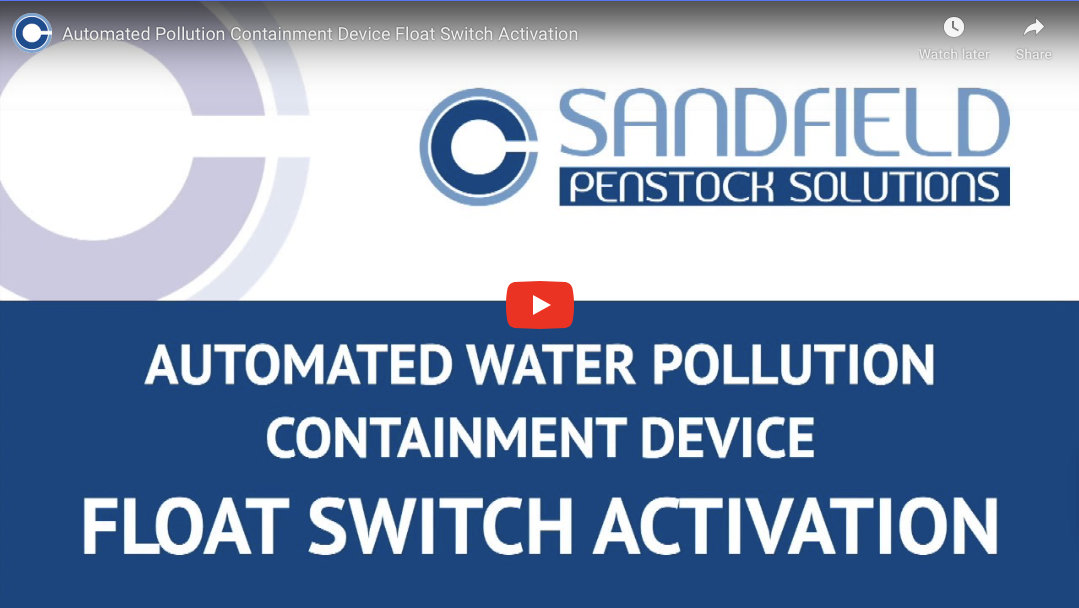Automated Containment Valve – Float Switch Activation
Hello, welcome to another Sandfield Penstock Solutions training video
I’m looking today at our ToggleBlok automated containment valve system and going through some of the simple operations of how to operate it automatically.
What you can see here is a 300 mm Toggleblok automated containment valve. We have placed this one in what we call the on-seated position so the water’s flowing in that direction so it’s going to be aiding the pressure of the automated containment valve to seal. The automated containment valve can also be seated in the off-seated orientation.
What you have to remember is when you put the valves in the off seating, or the spill position as I like to call it, that means the water is pushing the flap open so you don’t get so much control of the built-up head pressure. The 300 mm automated containment valve is quite capable of taking a three meter head pressure, so it’s a pretty significant volume of liquid that can be contained.
If you opt for the on-seated position you can actually effect a complete dead stop, so you can put these valves into a firewater containment system in accordance with CIRIA c736.
What we have here is a control panel which is our battery operated, solar charged model. The valves can also be mains powered depending on what you want to use it for, whether the panel is going inside or outside – but this is a battery-powered containment valve.
What we are going to do now is to close the automated containment valve. It’s a simple press locally of the red button so the automated containment valve is now is closed. You see that we’ve got a red LED and you can hear a little sounder buzzing, that’s just whilst it checks itself to make sure that it’s actually reached the closed position. When it reaches the closed position, as you can see here, I’ve got a message to my mobile phone just telling me that the automated containment valve is now in the closed position. The alarm carries on whilst its doing doing that check, it takes a minute and now you can see that it’s finished.
Now you could effectively remove this control panel and that automated containment valve will remain in the locked position. It will not open again, it will stay in that position until you apply a signal to open it.
What I am going to do now is press the green button, which is the open button, and you can see now I have a green LED, green for go, which means the flow can now continue. The automated containment valve has a drain down port which means that it can automatically drain down because if you have a contained a large head of water you can’t just release that when you’ve decided you want to open the containment valve. If you’ve had it shut for several days you will have a lot of water contained and you have to release it slowly, or better still remove it with a tanker and dispose of it appropriately.
We get asked a lot of questions about how to simply automate our automated containment valve, and it is really simple.
What I have done here is connect a float switch. You could have this in a sump, if you’re a site that operates an effluent treatment process and you are likely to have a sump in the ground and if it did fill up and overflow that could potentially breach the surface water network.
The enquiry we had last week was from from a site that used a sump. They already had a ToggleBlok on their drainage network, in the surface water drain, in the effluent treatment plant process area. What they wanted to do was, if the effluent treatment plant sump ever filled up the valve would automatically close and send a notification to tell them they’ve got a fault in their effluent treatment process. This would provide extra protection so that pollutants couldn’t get released and cause contamination or pollution issues from a problem with the effluent treatment plant
Quite simply the float normally is normally in an open switched position and as it turns it moves into a closed switch position that has now activated the containment valve. The red LED comes on and the alarm sounds whilst it is doing its checks. If I look on my phone the notification has just come through now to say that the automated containment valve is closed. The containment valve is now completely closed and locked off and you cannot open the automated containment valve whilst we still have the float switch in the closed position. Crucially you cannot simply open the automated containment valve, you have to look at what caused the pollution incident and sort it out. You can’t just override the system unless you disconnected the float switch, but I think that’d be a rather foolish thing to do.
Once you have cleaned out the sump and addressed the pollution risk, it is now safe to release the automated containment valve with a simple press of the green button. The automated containment valve is now going into the open position, just wait for the LED whilst its doing its checks to see that it’s in the right position.
These automated containment valves have sensors so they know whether they are closed and actually whether they are open. It’s now satisfied that it’s in the open position, it’s giving us a confirmation, the sound has gone off if there had been a fault we’d have been aware of an amber light and the system would have stayed in alarm.


